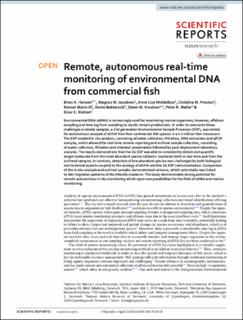| dc.contributor.author | Hansen, Brian K | |
| dc.contributor.author | Jacobsen, Magnus W | |
| dc.contributor.author | Middelboe, Anne Lise | |
| dc.contributor.author | Preston, Christina M. | |
| dc.contributor.author | Marin III, Roman | |
| dc.contributor.author | Bekkevold, Dorte | |
| dc.contributor.author | Knudsen, Steen Wilhelm | |
| dc.contributor.author | Møller, Peter R. | |
| dc.contributor.author | Nielsen, Einar E | |
| dc.date.accessioned | 2020-09-18T08:32:33Z | |
| dc.date.available | 2020-09-18T08:32:33Z | |
| dc.date.created | 2020-09-14T09:47:56Z | |
| dc.date.issued | 2020 | |
| dc.identifier.citation | Scientific Reports. 2020, 10, 13272. | en_US |
| dc.identifier.issn | 2045-2322 | |
| dc.identifier.uri | https://hdl.handle.net/11250/2678420 | |
| dc.description.abstract | Environmental DNA (eDNA) is increasingly used for monitoring marine organisms; however, offshore sampling and time lag from sampling to results remain problematic. In order to overcome these challenges a robotic sampler, a 2nd generation Environmental Sample Processor (ESP), was tested for autonomous analysis of eDNA from four commercial fish species in a 4.5 million liter mesocosm. The ESP enabled in situ analysis, consisting of water collection, filtration, DNA extraction and qPCR analysis, which allowed for real-time remote reporting and archival sample collection, consisting of water collection, filtration and chemical preservation followed by post-deployment laboratory analysis. The results demonstrate that the 2G ESP was able to consistently detect and quantify target molecules from the most abundant species (Atlantic mackerel) both in real-time and from the archived samples. In contrast, detection of low abundant species was challenged by both biological and technical aspects coupled to the ecology of eDNA and the 2G ESP instrumentation. Comparison of the in situ analysis and archival samples demonstrated variance, which potentially was linked to diel migration patterns of the Atlantic mackerel. The study demonstrates strong potential for remote autonomous in situ monitoring which open new possibilities for the field of eDNA and marine monitoring. | en_US |
| dc.language.iso | eng | en_US |
| dc.publisher | Nature Research | en_US |
| dc.rights | Navngivelse 4.0 Internasjonal | * |
| dc.rights.uri | http://creativecommons.org/licenses/by/4.0/deed.no | * |
| dc.title | Remote, autonomous real‑time monitoring of environmental DNA from commercial fish | en_US |
| dc.type | Peer reviewed | en_US |
| dc.type | Journal article | en_US |
| dc.description.version | publishedVersion | en_US |
| dc.source.volume | 10 | en_US |
| dc.source.journal | Scientific Reports | en_US |
| dc.identifier.doi | 10.1038/s41598-020-70206-8 | |
| dc.identifier.cristin | 1829549 | |
| cristin.ispublished | true | |
| cristin.fulltext | original | |
| cristin.qualitycode | 1 | |

